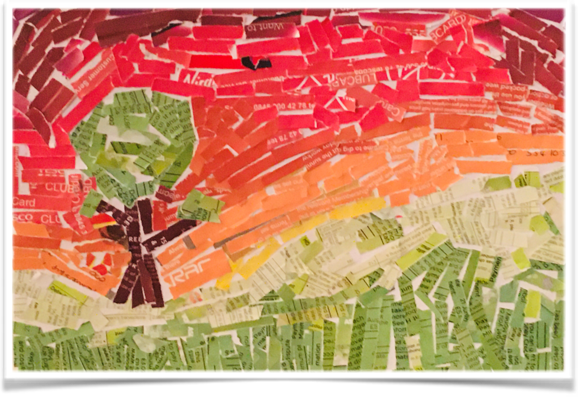Keep it Happy “What is the point of Angry?”
We all experience anger differently and the language we use to describe anger is explosive - we fume, we flare, we vent, we seethe, we blow up and we rage. But what's the point of Anger? Written by trainee, Ollie Coach, Deborah Stephenson.

“I don’t want to be angry…” yelled my 11 year old during an outburst the other day, “I don’t like being angry…” She clenched her fists and growled a “GRurrrrgh…” in her throat. “Anyway,” she continued, crossing her arms fiercely and frowning at me “…What is the point of angry?”.
It’s a fair question, and let’s face it, angry doesn’t have a great reputation. It’s often seen as a ‘bad’ emotion and a problem, and for most of us it’s an unpleasant experience. It doesn’t feel good when we’re in it and there are usually a lot of uncomfortable feelings afterwards – shame, guilt, remorse, humiliation, self reproach to name but a few.
We all experience anger differently, but as with other emotions, it causes a physical reaction in our bodies. That’s because anger is our natural and instinctive response to fear and threat, and it’s a return to that fight, flight or freeze response we have deep within our DNA. Our body releases adrenaline, our heart rate and blood pressure increase, muscles tense and tighten and we might feel hot and sweaty. Our senses sharpen and we become fixated on this “thing” that has angered us.
For me, it feels like a column of heat right in the core of my body, building and rising. My face feels tight and frowny, my muscles feel stiff, and my breathing gets quicker. An unpleasant energy charges across my shoulders and down through my arms. Everything is blurry, apart from the “thing” that’s making me angry, which is in sharp focus. I don’t how it is for you, but I’m guessing it’s something similar.
The language we use to describe anger is explosive – we fume, we flare, we vent, we seethe, we blow up and we rage. We talk about a “red mist” descending, clouding our reason and judgement. Drawings of anger are often made with made with hard thick lines or frantic scribbles, typically dark or red or fiery.
I’m reminded of the character Anger in the Pixar movie “Inside Out”. 
I don’t know if you’ve seen it, but it’s a story told by five emotions inside the mind of eleven year old Riley who, having moved home and changed school, encounters the fear, uncertainty and anxiety that brings. Anger is a short, red, growly character in a shirt and tie, with a big frown forehead and a grimace … oh, and when he’s really angry, flames burst from his head… we’ve all been there (metaphorically)!
Just the other day I made dinner and called the children to come downstairs to eat. After a short time my daughter arrived at the table and I called my 13 year old son again (nicely), and again (still quite nicely), and again (less nicely), and then whoosh, the anger rushed in and I was at the bottom of the stairs bellowing “GET DOWN HERE NOW!” at the top of my voice… immediately feeling all the heat and tension that had so speedily arrived, trickle away, to be replaced by a dull sense of regret.
What was that about? I wasn’t under threat or fearful, but as we know, emotions are complex, and are not always what they seem, which brings us back to the main question… “What is the point of Angry?”. When we dig down, we find that the triggers for anger are many other emotions like anxiety, sadness, fear, guilt, disappointment, worry, embarrassment, jealousy, and hurt.
Having given my dinner time fury some thought, I think I felt unappreciated and ignored. It had taken time and effort to cook the meal, and by not coming downstairs as I asked, and letting it go cold, it seemed as if my son didn’t care. It didn’t seem important to him and ultimately that hurt. It’s just a small example, but it is interesting to explore what’s really at the root of our annoyance.
Actually, anger (as long as we are not a danger others or ourselves) is useful. It shows us that we care – it’s actually quite hard to get angry with things you don’t care about, and it can be triggered by our sense of integrity and justice; “That’s Anger,” says Joy, one of the other emotion characters in the Inside Out film, “He cares very deeply about things being fair.” As the film develops we can see that the motivation behind Anger’s actions are really to protect Riley and stand up for her.
Anger also shows us that something isn’t right with a situation and can be a great motivator for change. If we take notice of what is making us angry we can try to do something about it. Those words that describe anger are dynamic and full of energy, so if we can channel that in a positive way, we can change what is wrong with the situation. Many big political changes across the world have happened and continue to happen through a sense of anger and justice.
Displaying our anger also communicates that something isn’t right to other people. Returning to my daughter, although she couldn’t work out at first why she had been angry (over something neither of us can even remember now!), after some hugs and a chat, it turned out that behind it all was a sense of insecurity and worry. After being strong, determined and working hard for most of the term, she was feeling exhausted and a bit overwhelmed with her new secondary school, and she was anxious about the Covid situation.
Her angry outburst was a signal that she needed reassurance, and talking it through gave her an understanding of what was troubling her. “Poor angry…” she said as she tucked down to sleep “I think he’s had a difficult day!”
So yes, it can be all consuming, and at that moment, it can feel bleak and destructive, but ultimately the underlying purpose of anger is good. Next time it happens to you or to someone around you, take a moment to think and investigate … What was the real point of that angry?
And there’s something else too…
The same rules apply to all the other “negative”, or as I prefer to call them, “tough” emotions like sadness, fear, jealousy, disappointment and worry. Asking “what is the purpose of this emotion?” is a good and useful question. Every emotion is valid, every emotion is a part of us and every emotion influences how we behave.
Don’t just plough on, ignoring them or pushing them aside, in fact, repressing emotions can often make things worse, so ask yourself is this tough feeling all that it seems? What might you need to address? What positive action can you take to make a difference?
Oh and in case you are wondering, I decided to share how I felt about the dinner thing with my son. He was a bit surprised and very sorry. He hadn’t considered how it might have made me feel and was a reminder that our actions often have an impact way beyond our intention… but that’s another subject for another day!
Deborah Stephenson, Ollie Coach trainee
I am an Ollie School trainee and a Director at an Independent Prep School for boys. I am a trained journalist and worked in BBC Local Radio for more than twenty years as a reporter, bulletin reader, news editor and programme maker. It was a great job, but I wanted to do something to support my own children’s wellbeing with a view to taking that on to support others and, in pursuit of a better work life balance, I resigned as the Assistant Editor of BBC Essex last year. Inspired by the Ollie School concept I was excited to be accepted for the training course and it has been a fascinating and enlightening and journey so far.
To get in contact with Deborah, email info@ollieandhissuperpowers.com
To find out more about Ollie and his Super Powers and how to become an Ollie Coach go to https://www.ollieandhissuperpowers.com/pages/about-us
Caroline Chipper
Director
Co founder of Subconquest Ltd, that trades as Ollie and his Super Powers. My many years of commercial experience is being put to good use managing the business side of Ollie, including working with our Ollie Coaches, and managing our contracts. In everything we do its about making a difference to those we work with. To find out more go to https://www.ollieandhissuperpowers.com/pages/about-us


